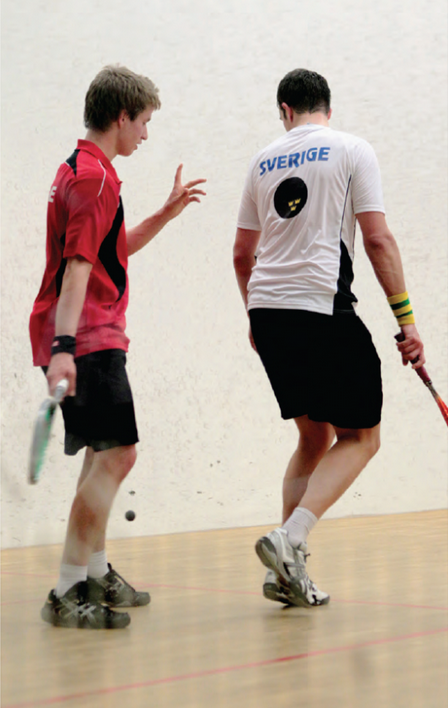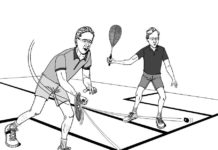By Barry Faguy, WSF Referees and Rules Committee
Depends what I’m wearing! Badda- boom! OK, old joke; couldn’t resist. Nonetheless, it’s a common question from the Referee. Something happens, play stops, and we assume an appeal is coming. Then, nothing; not a word, not a finger, not a look. Maybe the player is conceding the point? Time for that question. But for some snarky players who think the appeal was obvious, you might hear: “No, I’m ordering a pizza!” On the flip side, many a hapless Referee has awarded a Let (or even a Stroke), only to be told that no appeal was made. Whoops! Time for a quick review of some of this ‘appeal’ stuff.

Distinctions
Currently, the word ‘appeal’ is used to refer to any request for a ruling by the Referee— whether it be about an interference situation or other issue. That’s how we’ll use the word today, but it’s worth noting that the next edition of the rules (probably April 2014) will make a distinction between an ‘Appeal’ (a request to review a call or lack of a call by the Marker), and a ‘Request for a Let’ (a request for a decision about interference, distraction, or a fallen object). The idea is to promote clarity and eliminate some confusing situations that can otherwise occur.
Who may appeal?
Your decision as a Referee can be made easier if you know exactly who can appeal for what. As things stand (there will be an exception in the new rules), only the striker can appeal for the most common problem—interference. Either player may appeal for Marker issues—distraction, fallen object, or broken ball. This distinction often plays a crucial role during interference collisions and, as a Referee, you have to pay close attention to which player is in what role at each point along the way. For example, the non-striker may get knocked over by the incoming striker, but if that movement was reasonable, the non-striker has no right to appeal.
What is allowed as a method of appeal?
The rules state that a player should speak aloud and say either “Let, please” or “Appeal, please”—but almost in the same breath, the same rules allow anything that you, as the Referee, decide to accept. Those alternatives can be anything from a raised finger, a raised arm, or a raised eyebrow! Many times, a player just stops, looks nowhere in particular, and expects a decision. Be wary of this potentially unfair silent approach— because the player might now be expecting you to choose the most advantageous moment in their favor for the appeal. In any case, whatever you accept, make sure, as alluded to in the first paragraph, that the player is indeed appealing and not just conceding the point. The way to do that is with that first question.
How does a single official handle an appeal?
Most times, you referee alone, so the players get two for the price of one! You are given the dual function of both Marker & Referee. Remember, however, that the appeals are only addressed to you in your capacity of Referee. If the appeal had to do with interference, then your decision is final because there is only one level of decision making— you as Referee. On the other hand, if the appeal relates to an occurrence while you functioned as Marker (e.g., the score, line calls, etc), then the dual-function concept kicks in because that call or non-call is not final. Marker issues are always appealable— but now to you as you change function and put on your Referee hat. And strangely enough, you could consider your call or non-call as Marker to be doubtful or incorrect—and so you would proceed to correct yourself. Ouch! It’s entirely reasonable for you to order (upon appeal, of course), a Let to be played, if for example, you had doubts about a non-call close to a line—or alternatively, if you actually did call ‘Out’ but realize that you spoke too quickly, mistakenly believing that the ball was certain to go out. Don’t feel bad— we’ve all done it.
Can you ignore an appeal?
Yes—and it’s not impolite! Occasionally it’s the fair thing to do. Sometimes it’s because the issue is moot if a preceding incident settled the issue (as in a ball going down immediately before a player asks for a let). Another example occurs when the striker has hit a winner—and then the unchecked follow-through immediately hits the opponent. The striker often immediately appeals out of concern for injury, but the fair thing to do is ignore the appeal and let the winner stand.
What is an ‘early’ appeal?
No, it’s not an appeal before the match begins. This is extremely common, especially at higher levels of play. First some background: the formal changeover point between striker and non-striker is the moment the ball hits the front wall. So, it often happens that the incoming player (not yet technically the striker), appeals for a let for interference before the other player’s return reaches the front wall. This happens mostly with drops, boasts, and slower returns of that nature. An overly picky or harsh Referee might not even entertain the appeal and so deny the Let because of that technicality. However, considering the speed of some situations and some players, common practice is to indeed accept the request and then proceed to make the judgment about the situation. In fact, the new rules (them again!) will contain an exception that will allow such ‘early’ appeals in cases of ‘access’ interference only.
How quickly must a player appeal?
The rules specify that appeals for interference must be immediate. A player who accepts the interference, plays through, and then stops play (usually realizing too late the difficulty of the return), is out of luck. However, take care not to apply this ‘immediate’ concept to those instances of backswing contact or big collisions. For example, it is just about impossible to stop a backswing in full motion—and even more, to have the presence of mind to call out for a Let in the middle of it all when contact is unexpected.
Also, an immediate appeal can’t apply to Marker non-calls. A player would be taking a big chance in stopping the rally hoping the Referee agrees that the Marker made a mistake. As they say in the Old West, better to shoot first and ask questions later! Playing a Let is the typical result since at best, you can only be uncertain about the noncall— otherwise you would have stopped play right then—right?!
What about a generic appeal?
Occasionally, at the end of a long rally, you’ll hear the losing player ask: “Were all balls good?” This is a question that you should not answer—but instead, ask in return: “Which return are you referring to?” A player who appeals that way is, for all intents and purposes, asking you to pick any doubtful or unseen return in the rally…and favor him or her with a Let. There would be no end to all of this—to say nothing of it being unfair. In fact, to preclude such appeals and make this point even clearer than it is now, the new rules will have wording requiring that a player specify which return is being appealed.
However, a player is indeed allowed to make more than one appeal for a given rally—and they must be dealt with in the order in which they occurred during the rally—since a decision on an earlier one might preclude having to deal with subsequent ones.
So, OK, that wasn’t a very exciting topic, but you can be sure that you’ll be needing that information somewhere along the way.





